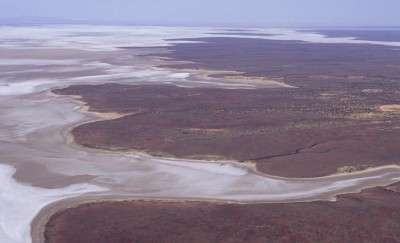The origins and future of Lake Eyre and the Murray-Darling Basin

Geoscientists have, for the first time, discovered the origins of Australia's two largest basins: Lake Eyre and the Murray-Darling Basin. The research also implies that in 30 million years' time both basins will cease to exist.
Monash University geoscientist Associate Professor Wouter Schellart, and his colleague Professor Wim Spakman from Utrecht University, have discovered how the floor of an entire ocean basin that was destroyed 70 to 50 million years ago off the North coast of New Guinea is currently located at 800-1200km depth below Central and South-eastern Australia.
Using supercomputers, the researchers found that this dense piece of ocean floor material (called a lithospheric slab) is slowly sinking into the Earth's mantle and is responsible for the formation of the Lake Eyre Basin, one of the Earth's largest internally drained basins and home to the lowest point in Australia at 15m below sea level, as well as the Murray-Darling Basin, home to the largest river system in Australia. With a combined surface area exceeding 2 million square kilometres, both basins are located directly above the deep mantle slab.
The research also predicts that in 30 million years from now, when Australia has moved about 1500km northwards, the fossil slab will be located below the Southern Ocean and, as a consequence, the Lake Eyre Basin and Murray Darling Basin will cease to exist.
Using geological and geophysical data from the New Guinea region, Schellart was able to reconstruct the geological evolution of the region over the last 70 million years, including the motion of the tectonic plates and plate boundaries. He discovered that the occurrence of deep ocean floor rocks, volcanic rocks and deformed rocks, which are currently found in the mountain ranges of New Guinea, point to the existence of a 4000km wide subduction zone. At subduction zones such as these, an oceanic tectonic plate sinks (subducts) into the Earth's interior, the mantle.
With these plate tectonic reconstructions Schellart was able to predict where the fossil subduction zone was during its lifetime some 50-70 million years ago, and therefore where the lithospheric slab disappeared into the mantle. With a global seismic tomography model that makes use of seismic waves to map the internal structure of the Earth's mantle, Schellart and Spakman were able to identify the fossil slab structure below central and south-eastern Australia at a location and depth predicted by the reconstructions.
"When we first compared the predictions of our reconstructions with the mantle tomography model we were amazed by how perfectly they aligned," Associate Professor Schellart said.
The researchers then developed a computer model to simulate flow in the Earth's mantle to be able to predict the sinking velocity of the fossil slab and to investigate how this sinking might affect the Earth's surface. They found that although the slab is sinking at a rate of less than 1cm per year, this slow sinking generates a downward flow in the mantle that is sufficient to pull down the Earth's surface and create these huge basins.
"It is incredible to think that tectonic processes that took place millions of years ago at the northern margin of New Guinea are responsible for the landscape we see today in Central and South-eastern Australia," Associate Professor Schellart said.
The research was undertaken with the assistance of resources from the National Computational Infrastructure (NCI), which is supported by the Australian Government.
The research was published in the international journal Earth and Planetary Science Letters.
More information: Earth and Planetary Science Letters, www.sciencedirect.com/science/ … ii/S0012821X15001855
Journal information: Earth and Planetary Science Letters
Provided by Monash University


















